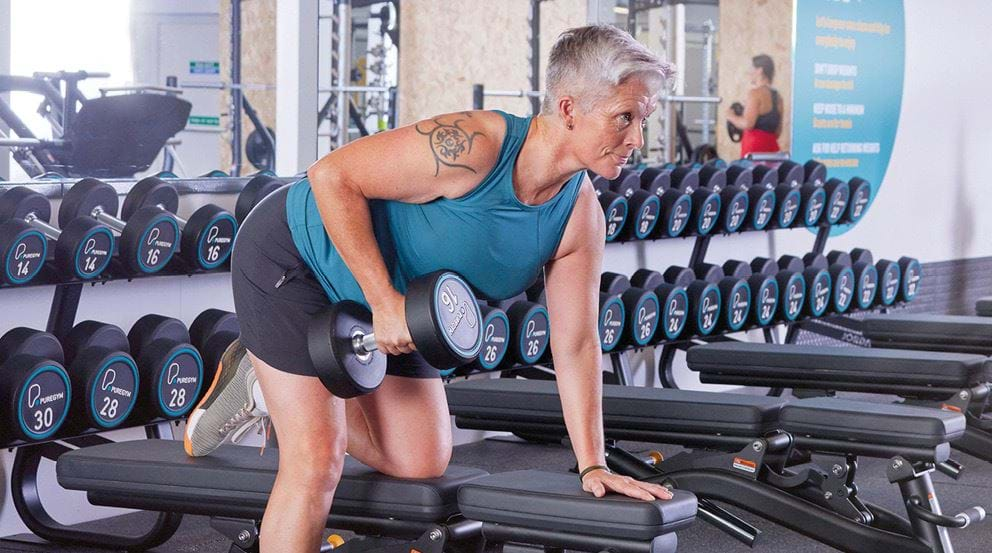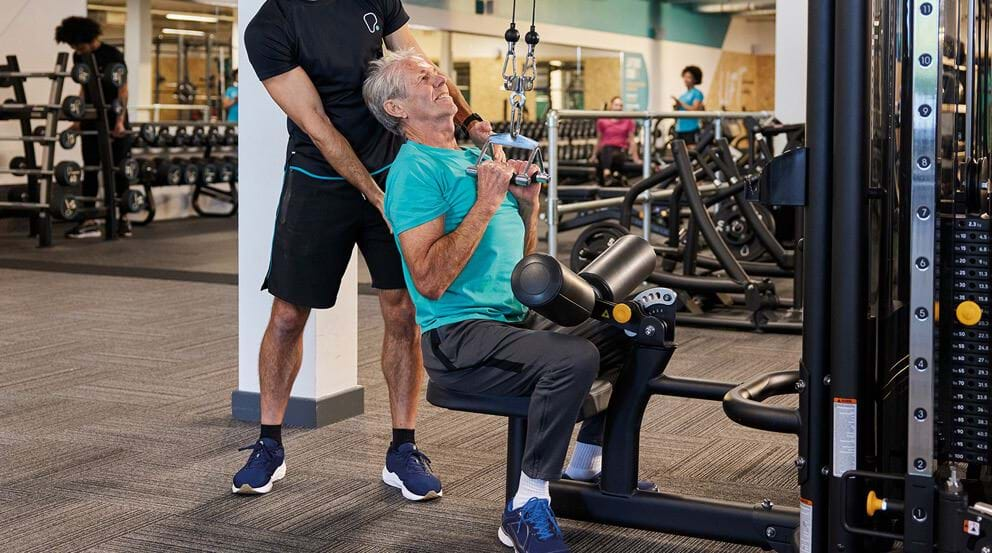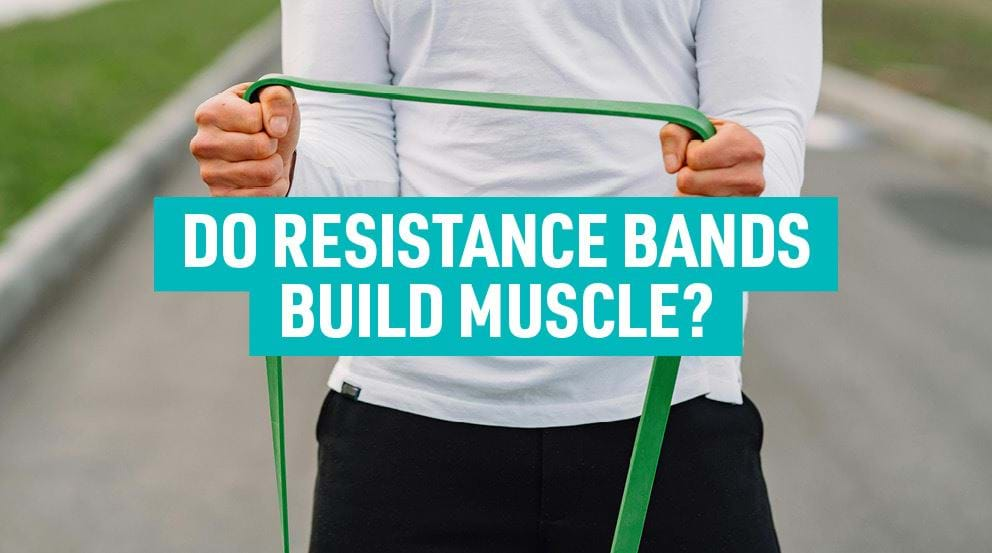Menopause and Muscle Mass: This Resistance Training Routine Helps You Stay Strong

How Menopause Impacts The Body | The Role of Strength Training for Menopause | What is Resistance Training | Why Resistance Training Helps With Menopause | Resistance Training Routine for Women in Menopause | Upper Body Exercises | Lower Body Exercises | Full Body and Core Exercises | How To Progress Safely
Whether you're in the perimenopausal stage and preparing for the changes ahead, or already going through menopause, strength training should be one of the things at the top of your list to look after yourself.
Strength training isn’t just an empowering thing to do, it helps to support your health and wellbeing, reducing symptoms and risks that come along with hormonal changes during menopause.
We’re here to help you understand why maintaining muscle is important for women during menopause, and how resistance training can help you reduce symptoms associated with this phase.
Plus, we’ll be sharing a resistance training routine you can follow when you next head to the gym.
How Menopause Impacts The Body
During perimenopause (the period of time before menopause, which can last for 2-8 years), oestrogen and progesterone levels start to decline.
When there has been no menstrual period for 12 months, you enter menopause, where oestrogen levels are permanently reduced.
These hormonal changes, particularly the change in oestrogen levels, can causes a number of symptoms such as irregular periods, hot flashes, and mood swings.
The reduction of oestrogen doesn’t just lead to hot flashes and mood changes though – it can impact your body in a number of ways that have more long-term implications.
Want to learn more about menopause and how it impacts the body? Discover more here.
The Role of Strength Training For Menopause
What is Resistance Training?
Resistance training, also known as strength training, is a type of exercise that uses weights or other forms of resistance to help build, challenge, and maintain muscles. The aim of resistance training is to boost muscle mass, strength, endurance, and power.
Why Resistance Training Helps with Menopause
Symptom: During menopause you can experience loss of muscle mass. A study found that compared to women in early perimenopause, those with menopause have 10% less muscle mass in their arms and legs.
How exercise can help: Resistance training helps counter loss of muscle mass. By regularly practicing strength training exercises, you can help the body maintain and even build muscle.
Symptom: Menopause increases the likelihood of bone density loss, with research showing that up to 20% of bone density loss can happen during menopause, and 1 in 10 women over 60-year-old are affected by osteoporosis globally.
How exercise can help: Resistance training helps build muscle, which helps to support bone health by improving bone density. This can lower the risk of osteoporosis and reduce the likelihood of fractures – both of which women with menopause are more at risk of, due to lower oestrogen levels.
Symptom: Menopause can cause muscle ache, joint pain, less flexibility, and less stability.
How exercise can help: Resistance training can support joint flexibility, stability and may even reduce pain, by strengthening the muscles and joints. This can reduce the stiffness and discomfort that many women experience during menopause.
Symptom: As oestrogen levels reduce in menopause, visceral fat increases from 5-8% to 10-15% total body weight and the metabolic rate slows as muscle mass decreases.
How exercise can help: Moving more, especially by doing resistance training exercises, can help you boost your metabolism. This can lower the risk of unhealthy fat gain, which is more likely during menopause.
Symptom: Menopause can lower your energy levels and leave you feeling tired and unmotivated. This is often caused directly by hormonal changes, but can also be linked to poor quality of sleep from symptoms like night sweats and hot flashes, of which 70-80% of women in menopause experience.
How exercise can help: Movement of any kind can help to boost energy levels by improving your cardiovascular health, improving your mood and boosting your sleep quality. This can combat low energy levels, and other negative symptoms that come with menopause.
Plus, exercise also helps you sleep better - it improves sleep quality, reduces the time it takes to fall asleep, and even helps reduce insomnia-associated anxiety.
The Ideal Resistance Training Routine for Women in Menopause
Before you try a new fitness routine, it’s always a good idea to consult a doctor or fitness professional beforehand, to ensure you’re moving in a way that is safe and effective for your individual needs.
We recommend using the training schedule below 2-3 times per week, with workouts lasting between 30-60 minutes per session for optimal results.
However, it's important to remember to listen to your body and take rest days when you think you need them if you're experiencing peri-menopause or menopause symptoms.
Warm-Up
Warming up is important as it prepares your body to take on more strenuous activity. It can help to prevent injury, as well as allowing you time to get into the right frame of mind for your session.
We suggest warming up by doing some light cardio such as brisk walking, dynamic stretches (such as arm circles and leg swings), or light bodyweight movements such as squats and jumping jacks.
Main Routine: Strength Training Exercises for Menopause
In this section of the guide, you will find 3 workout routines that you can try during the menopause period.
Each resistance training workout will include either upper body, lower body or full body exercises.
To allow your muscles to recover adequately between the resistance training workout sessions, we recommend you only complete one of the workouts per day and take rest days in-between.
Menopause Workout - Upper Body
Dumbbell Shoulder Press
How to do it: Stand or sit with a dumbbell in each hand at shoulder height (choose a weight that works for you). Press the weights overhead until your arms are fully extended, then lower them back to the starting position.
Benefits: Strengthens shoulders and upper back muscles, promoting better posture.
Lat Pulldown Machine
How to do it: Choose a weight that works for you on the machine. Sit at a lat pulldown machine and grasp the bar with a neutral or wide grip. Pull the bar down towards your chest, squeezing your shoulder blades together, then slowly return to the starting position.
Benefits: Targets the upper back and lats, improving upper body strength and posture.
Seated Row Machine
How to do it: Choose a weight that works for you on the machine. Sit at a seated row machine with your feet on the platform and grasp the handles. Pull the handles towards your torso while keeping your elbows close to your body, then slowly return to the starting position.
Benefits: Strengthens the upper back, shoulders, and arms while enhancing posture and stability.
Dumbbell Lateral Raises
How to do it: Stand with a dumbbell in each hand at your sides (choose a weight that works for you). Raise your arms out to the side until they reach shoulder height, then lower them back down.
Benefits: Builds shoulder strength and stability, helping to prevent age-related muscle loss.
Cable Face Pulls
How to do it: Choose a weight that works for you on the machine. Stand facing a cable machine with the cable set at chest height. Grasp the handle with both hands, keeping your arms slightly bent.
Step back to create tension in the cable, then pull the handle towards your chest while squeezing your shoulder blades together. Slowly return to the starting position and repeat.
Benefits: Targets the upper back, shoulders and arms, helping to improve posture and strengthen the muscles that support the spine. It also engages the core for stability.
Menopause Workout: Lower Body
Barbell Back Squats
How to do it: Choose a weight that works for you, or you can start off using just the bar or completely bodyweight. Stand with your feet shoulder-width apart. Lower your body by bending your knees and pushing your hips back, keeping your chest up.
Go as low as you can while maintaining good form, then push through your heels to return to the starting position.
Benefits: Strengthens the quadriceps, hamstrings, glutes, and improves overall lower body stability and balance.
Learn how to do barbell back squats or take a look at all the other variations you can try.
Lunges
How to do it: Stand tall with your feet together. Step forward with one leg, lowering your hips until both knees are at about a 90-degree angle. Push back to the starting position and switch legs.
If you feel ready to incorporate weights, you can add some dumbbells in your hands, either side of you.
Benefits: Targets the quadriceps, hamstrings, and glutes, while also improving balance and coordination.
Learn how to perform a forward lunge or take a look at all the other variations you can try.
Leg Press Machine
How to do it: Choose a weight that works for you on the machine. Sit on a leg press machine with your back against the pad and feet shoulder-width apart on the platform. Push the platform away by extending your legs, then slowly lower it back down to the starting position.
Benefits: Strengthens the quadriceps, hamstrings, and glutes with controlled movement.
Glute Bridges
How to do it: Lie on your back with your knees bent and feet flat on the floor, hip-width apart. Press through your heels to lift your hips toward the ceiling, squeezing your glutes at the top, then lower back down.
Benefits: Strengthens the glutes, hamstrings, and lower back, promoting better pelvic stability and posture.
Learn how to do a Glute Bridge or take a look at all the other variations you can try.
Dumbbell Step Ups
How to do it: Select your dumbbells (weights that suit you) and hold one in each hand. Stand in front of a box or step. Step up with one foot, pressing through your heel, and bring the other foot up to meet it. Step back down with the same foot, then repeat with the other leg.
Benefits: Strengthens the quadriceps, hamstrings, and glutes while improving balance and coordination. Step-ups also mimic everyday movements, making them functional.
Menopause Workout: Full Body and Core
Deadlifts
How to do it: Stand with your feet hip-width apart underneath your barbell. We have a range of barbell weights, so pick what is right for you. Sitting back and down, grip the barbell slightly wider than shoulder-width.
Use your leg muscles to raise the barbell, driving your hips forward once the bar reaches knee height until you are standing upright. Reverse the movement and return the bar either to the floor or just above the floor and repeat.
Benefits: Deadlifts strengthen not only the hamstrings and glutes but also engage the core, promoting stability and balance. This exercise enhances overall core strength and improves posture, which is especially beneficial during menopause.
Learn how to perform Deadlifts or take a look at all the other variations you can try.
Kettlebell Swings
How to do it: Stand with your feet shoulder-width apart, holding a kettlebell or dumbbell (at a weight that suits you) with both hands.
Hinge at your hips and swing the weight between your legs, then explosively thrust your hips forward to swing the weight up to shoulder height. Allow it to swing back down and repeat.
Benefits: Engages the entire body, including the core, glutes, and legs, while improving cardiovascular fitness and functional strength.
Plank
How to do it: Begin in a push-up style position with your forearms on the ground and elbows aligned under your shoulders. If you need more support, you can drop your knees to the floor and take a kneeling position. Try to keep your body in a straight line from head to heels. Hold this position for as long as you can while maintaining proper form.
Benefits: Strengthens the core, shoulders, and back, improving overall stability and posture.
Russian Twists
How to do it: Sit on the floor with your knees bent and feet flat. Lean back slightly, holding a weight or medicine ball with both hands. Rotate your torso to one side, then the other, tapping the weight on the ground beside you each time.
Benefits: Engages the obliques and strengthens the core while enhancing rotational stability.
Deadbugs
How to do it: Lie on your back with your arms extended toward the ceiling and your knees bent at a 90-degree angle. Lower your right arm and left leg toward the floor while keeping your back flat.
Return to the starting position and switch sides. You can incorporate small weights that suit you, if you want to.
Benefits: Strengthens the core and improves coordination while promoting spinal stability.
Cool Down
Stretching after a workout can help improve recovery times, reduce muscle tension, and bring your heart rate back down to baseline. We would recommend doing cooldown exercises that focus on the major muscle groups that you have chosen to workout.
For example, if you have done a lower body workout, hamstring stretches, quad stretches, and hip flexor stretches will be useful. If you’ve done an upper body workout, stretches like shoulder, chest, back, and tricep stretches are useful.
How to Progress Safely: 3 Tips
Track your progress:
Make sure that you’re always tracking your progress by tracking your workouts and the weights you have used.
This makes it easier to know where and how to keep pushing, and it keeps you mentally motivated to keep hitting the gym.
Just remember, menopause symptoms may fluctuate and therefore you may feel less motivated and able at times.
Exercise journeys aren’t linear, so make sure you’re kind to yourself and always do what feels right for you.
Increase weight gradually:
As you begin to feel stronger, you can increase the weights you are using to perform these exercises or increase the number of reps you are doing at the same weight.
Gradually increasing either of these variables is called progressive overload and will stimulate the muscles to get stronger and continue working hard.
Make sure you rest:
Rest days are incredibly important to ensure that you’re not burning out. We recommend 2 to 3 rest days, minimum, per week.
On these days you can still do light cardio such as walking, but make sure you’re prioritising your recovery on these days so when you do get back to the gym you have the energy to give it your all.
If you need more rest days one week than on another, or you take a longer break from the gym, remember that’s OK – focus on always being kind to yourself and moving in a way that suits you.
Get Empowered Through Strength
Ready to start your own strength-building journey to make sure you’re protecting your health and wellbeing throughout menopause?
We have so many resources to help you, and PTs at PureGym are always on hand in our gyms to give you extra support and guidance if you need it.
So, what are you waiting for? Let’s get moving!


